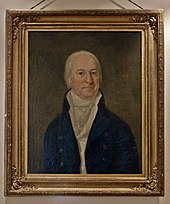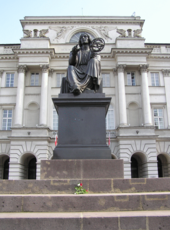Staszic Palace
| Staszic Palace Pałac Staszica (in Polish) | |
|---|---|
 Staszic Palace, seat of the Polish Academy of Sciences | |
 | |
| General information | |
| Architectural style | Neoclassical |
| Town or city | Warsaw |
| Country | Poland |
| Construction started | 1620 |
| Completed | 1946-50 |
| Design and construction | |
| Architect(s) | Antonio Corazzi |
Historic Monument of Poland | |
| Designated | 1994-09-08 |
| Part of | Warsaw – historic city center with the Royal Route and Wilanów |
| Reference no. | M.P. 1994 nr 50 poz. 423[1] |
Staszic Palace (
History
Origin
The history of the Staszic Palace dates from 1620, when
As the Polish capital's population was mostly
19th century

In 1818 the building was purchased by
On 11 May 1830 the diplomat and polymath, Julian Ursyn Niemcewicz, unveiled Bertel Thorvaldsen's monument to Nicolaus Copernicus in front of the palace.[2]
After the November 1830 Uprising against the occupying Russian Empire, the Society was banned by the Russian authorities; they had controlled Warsaw for most of the time since the final partition of Poland in 1795. For the following 26 years, the palace was used by the organisers of a lottery.
In 1857–62 the palace was the seat of the Academy of Medical science, the first institution of higher learning re-established in the
Until the end of World War I, the building housed a
20th century

After
The palace was damaged during the 1939 siege of Warsaw and nearly razed during the 1944 Warsaw Uprising. In 1946–50 it was rebuilt in its original neoclassical form by Piotr Biegański who introduced minor modifications to the building's original design.[4] Today it is the seat of the Polish Academy of Sciences.
Notes
- ^ Zarządzenie Prezydenta Rzeczypospolitej Polskiej z dnia 8 września 1994 r. w sprawie uznania za pomnik historii., M.P. z 1994 r. Nr 50, poz. 423
- ISBN 0-7385-0716-4, pp. 13-14.
- ISBN 83-223-2047-7.
- ISBN 978-83-280-3725-0.
External links
![]() Media related to Staszic Palace at Wikimedia Commons
Media related to Staszic Palace at Wikimedia Commons
- (in Polish) Gallery of photos and a history
